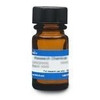Pretomanid is a bicyclic nitroimidazole and small molecule pro-drug that is active against actively replicating and hypoxic non-replicating Mycobacterium tuberculosis, the causative agent of tuberculosis (TB). It is activated by deazaflavin-dependent nitroreductase. Other mono- and multidrug-resistant strains of M. tuberculosis exhibited comparable susceptibilities to Pretomanid, indicating no cross-resistance with current anti-TB drugs.
| Mechanism of Action | Pretomanid has a complex mechanism of action, with differing aerobic and anaerobic activity. Aerobic activity includes cell wall inhibition via mycolic acid biosynthesis. Anaerobic activity has Pretomanid acting as a nitric oxide donor, resulting in respiratory poisoning through nitric oxide release. The nitric oxide possibly reacts with cytochromes to interfere with electron flow and ATP homeostasis under hypoxic conditions. Nitric oxide has multiple targets including as many as 29 mycobacterial enzymes (Manjunatha et al, 2009). Understanding the interaction between Pretomanid and the target bacterial metabolome is important to contribute to the discovery of new TB candidates. |
| Spectrum | Effective against Mycobacteria tuberculosis. |
| Molecular Formula | C14H12F3N3O5 |
| Microbiology Applications | Pretomanid was tested in vitro against a broad panel of multidrug-resistant clinical isolates and was found to be highly active against all isolates tested (MIC<1 ug/ml) (Lenaerts et al, 2005). Pretomanid was also tested on M. tuberculosis growing as a biofilm/pellicle, a bacterial phenotype known to be more resistant to antibiotic treatment. Light levels from bioluminescently-labeled M. tuberculosis were used as a surrogate for bacterial viability. The organism growing as this phenotype was resistant to the majority of compounds tested, with MICs increasing from 20-fold to > 1000-fold.(Dalton et al, 2016). The MIC value of Pretomanid against bacteria growing in a planktonic way was 0.011 mg/L and increased to >3.6 when it was compared to the biofilm phenotype (Dalton et al, 2016). |
| References | Baptista R, Fazakerley DM, Beckmann M, Baillie L and Mur LAJ (2018) Untargeted metabolomics reveals a new mode of action of Pretomanid (PA-824). Sci. Rep 8(1):5084 PMID 29572459 Bielecka MK et al (2017) A bioengineered threedimensional cell culture platform integrated with microfluidics to address antimicrobial Dalton JP et al (2016) Effect of cmmon and exprimental anti-tuberculosis treatments on Mycobacterium tuberculosis growing as biofilms. PeerJ 4:e2717 Lenaerts AJ et al (2005) Preclinical testing of the nitroimidazopyran PA-824 for activity against Mycobacterium tuberculosis in a series of in vitro and in vivo models. Antimicrob. Agents Chemother. 49(6):2294-2301 PMID 15917524 Manjunatha U, Boshoff HI, and Barry CE (2009) The mechanism of action of PA-824: Novel insights from transcriptional profiling. Commun. Integr. Biol. 2(3):215-218 PMID 19641733 Rhee KY, Erdjument-Bromage H, Tempst P, Nathan CF (2005) S-nitroso proteome of Mycobacterium tuberculosis: Enzymes of intermediary Stover CK et al (2000) A small-molecule nitroimidazopyran drug candidate for the treatment of tuberculosis. Nature 405(6789):962-966 PMID 10879539 |


